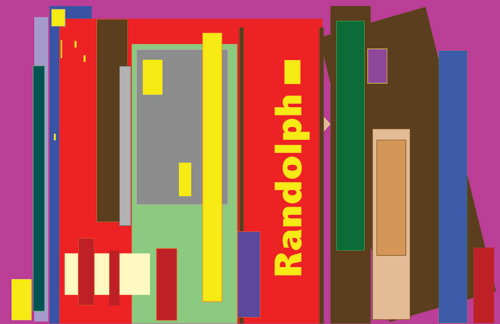
Cliff Eyland, Bookshelf File Card (2009), Inkjet print on paper, mounted to MDF, 7.6 x 12.7 cm
(3 x 5 inches)
Cliff Eyland
Leo Kamen, Toronto
My first encounter with Cliff Eyland’s often-bibliophilic work was in 1990, in the last of a series of ten more-or-less annual exhibitions at the Dalhousie Art Gallery surveying Canadian contemporary drawing. That exhibition contained unconventional meditations on drawing, and Eyland’s contribution consisted of a vast number of drawings, photographs and objets d’art on 3 x 5-inch file cards held in a library card catalogue — a then standard-issue piece of steel library furniture with manifold drawers of Dewey Decimal order. Viewers were encouraged to sit and rifle through an exuberant cacophony of poetically categorized felt-tip doodles as well as surreal erotica and staid Victorian monochrome portraits, both painted in acrylics — among much else.
Eyland is keen on representing a lot in his exhibitions, from the bawdy to the learned, and libraries are an effective metaphor for this sort of comprehensive vision. His current exhibition leans decidedly towards the learned, and represents an ideal library of richly chromatic book spines reproduced in miniature on ink-jet prints and then mounted on Eyland’s hallmark file card-scaled panels. Drawn with vector-graphics software, the spines of the books are mostly blank, but those that aren’t display the names of a range of authors from William Blake to Sylvia Plath to Jeanne Randolph — as well as cryptic musings where the book titles would normally be — such as There, There or Wondering. There are 110 panels in the exhibition.
The sources for these images are a pair of vector-graphics drawings that Eyland made in the summer of 2001 while on a residency in New York City, just before the attacks on the World Trade Center. The drawings imagined New York in the form of three-tiered library shelving — the city as slender, rainbow-hued towers of publications, all neatly lined up, with the Manhattan skyline shaped from contrasting book spines. Looking back, there now seems to be a measure of innocence in Eyland’s gesture. On the other hand, Eyland was in the city in part to continue his ongoing project of concealing his file-card drawings in books in the New School University’s library.
In keeping with this retrospective sensibility, the exhibition also includes diminutive geometric abstact paintings. These succinct works present fragments of book spines executed in the classic 1960s hard-edge painting technique, featuring layers of acrylic paint — a fastidious process of gradual accrual, not unlike the effort that results in a carefully maintained personal library. While there is wordplay and cheeky colour in this show, this is not Eyland’s usual miasma of impish reference, but a platonic proposition of library love.
Canadian Art Summer 2009